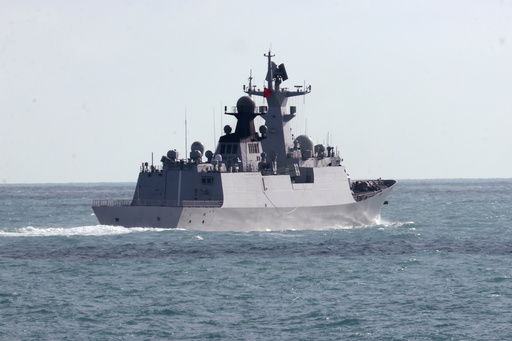
MELBOURNE, Australia — The military forces of Australia and New Zealand are keeping a watchful eye on three Chinese naval vessels that have ventured unusually far south along Australia’s eastern coastline, according to officials’ statements on Thursday.
Last week, the Australian government reported that these warships had transited through Southeast Asia and the Coral Sea and were nearing northeast Australia. Defense Minister Richard Marles confirmed on Thursday that the Chinese ships, specifically the naval frigate Hengyang, the cruiser Zunyi, and the replenishment vessel Weishanhu, are currently operating “off the east coast of Australia.”
Although defense officials did not provide details in response to a report from the Financial Times suggesting that the Chinese task group was positioned 150 nautical miles (about 278 kilometers) east of Sydney, Marles acknowledged that this situation, while not unprecedented, is still notable. “There is no doubt that this is, not unprecedented, but an unusual event,” he remarked during an interview with Sky News.
In a statement, Marles noted that Australian naval and air force units are actively observing the movements of the Chinese ships as they navigate through international waters within Australia’s exclusive economic zone—this is the area beyond territorial waters where a country retains exclusive rights over its resources. He emphasized that while Australia recognizes the rights of the Chinese vessels to be in this area, it is prudent for Australia to closely monitor their activities.
Further analysis will occur following the conclusion of the Chinese mission, providing insight into their objectives during this deployment, Marles commented. Meanwhile, in Beijing, Chinese foreign ministry spokesperson Guo Jiakun stated during a press briefing that he was unaware of the situation regarding the location of the Chinese warships, and the Chinese Embassy in Australia has yet to provide any comments.
Marles also mentioned that Australia consulted with neighboring Papua New Guinea concerning their response to the Chinese vessels, especially since the ships had navigated around Papua New Guinea prior to entering Australia’s exclusive economic zone. Additionally, he stated that Australia is collaborating closely with New Zealand for monitoring efforts, with New Zealand’s military coordinating maritime and aerial surveillance operations alongside Australia.
New Zealand Defense Minister Judith Collins confirmed this coordination and added that her country had not received any clarifications from the Chinese government regarding the deployment of these vessels or their future intentions. She reiterated that New Zealand would continue monitoring the situation closely.
According to Jennifer Parker, an expert associated with Australia’s National Security College and a former naval officer, it is rare for Chinese warships to operate so far south along Australia’s eastern coast. She pointed out that this movement is part of a larger strategy by the People’s Liberation Army Navy (PLA-Navy) to project power globally, indicating that similar activities may become more frequent in both the Pacific and Indian Oceans.
This Chinese naval activity coincides with a visit by Admiral Samuel Paparo, head of U.S. Indo-Pacific Command, to Australia this week. Parker suggested that the timing may be coincidental, as such military deployments are often planned long in advance, and information about U.S. military officials’ trips is disclosed only close to the event.
She emphasized that the purpose of this deployment appears to be a demonstration of capability to operate in Australian maritime zones. In response to the reports regarding the Chinese vessels, Prime Minister Anthony Albanese stated at a news conference that he is not particularly concerned, noting that the Chinese naval ships are operating within international law. He assured that Australia is diligently monitoring the situation as expected.
Historically, three Chinese naval ships visited Sydney Harbor in 2019, a journey sanctioned by the Australian government. While there has been some improvement in diplomatic and trade relations between Australia and China in recent times, military interactions between the two countries remain strained. Recently, Australia lodged a complaint over what it surveyed as an unsafe encounter in the South China Sea, involving a Chinese fighter allegedly endangering an Australian military surveillance plane by releasing flares.
In a contrasting narrative, Guo, the spokesperson for China’s foreign ministry, accused the Australian aircraft of intentionally intruding into airspace over the contested Paracel Islands, which are claimed by China.

